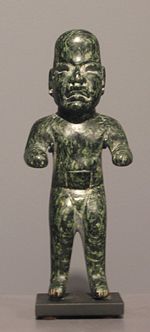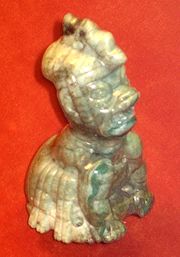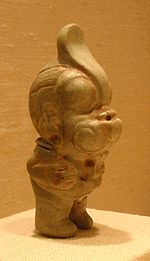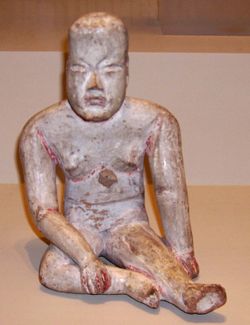
Olmec figurine
Encyclopedia
.jpg)
.jpg)
Figurine
A figurine is a statuette that represents a human, deity or animal. Figurines may be realistic or iconic, depending on the skill and intention of the creator. The earliest were made of stone or clay...
s produced by the Formative Period inhabitants of Mesoamerica
Mesoamerica
Mesoamerica is a region and culture area in the Americas, extending approximately from central Mexico to Belize, Guatemala, El Salvador, Honduras, Nicaragua, and Costa Rica, within which a number of pre-Columbian societies flourished before the Spanish colonization of the Americas in the 15th and...
. While many of these figurines may or may not have been produced directly by the people of the Olmec heartland
Olmec heartland
The Olmec heartland is the southern portion of Mexico's Gulf Coast region between the Tuxtla mountains and the Olmec archaeological site of La Venta, extending roughly 80 km inland from the Gulf of Mexico coastline at its deepest...
, they bear the hallmarks and motifs of Olmec
Olmec
The Olmec were the first major Pre-Columbian civilization in Mexico. They lived in the tropical lowlands of south-central Mexico, in the modern-day states of Veracruz and Tabasco....
culture.
These figurines are usually found in household refuse, in ancient construction fill, and (outside the Olmec heartland
Olmec heartland
The Olmec heartland is the southern portion of Mexico's Gulf Coast region between the Tuxtla mountains and the Olmec archaeological site of La Venta, extending roughly 80 km inland from the Gulf of Mexico coastline at its deepest...
) in graves, although many Olmec-style figurines, particularly those labelled as Las Bocas
Las Bocas
Las Bocas is a minor archaeological site in the Mexican state of Puebla, whose name has become attached, often erroneously, to a wide-ranging type of Olmec-style figurines and pottery....
- or Xochipala
Xochipala
Xochipala is a minor archaeological site in the Mexican state of Guerrero, whose name has become attached, somewhat erroneously, to a style of Formative Period figurines and pottery.-Archaeological site:...
-style, were recovered by looters and are therefore without provenance
Provenance
Provenance, from the French provenir, "to come from", refers to the chronology of the ownership or location of an historical object. The term was originally mostly used for works of art, but is now used in similar senses in a wide range of fields, including science and computing...
.
The vast majority of figurines are simple in design, often nude or with a minimum of clothing, and made of local terracotta. Most of these recoveries are mere fragments: a head, arm, torso, or a leg. It is thought, based on wooden busts recovered from the water-logged El Manati
El Manatí
El Manatí is an archaeological site located approximately 60 km south of Coatzacoalcos, in the municipality of Hidalgotitlán 27 kilometers southeast of Minatitlan in the Mexican state of Veracruz...
site, that figurines were also carved from wood, but, if so, none have survived.
More durable and better known by the general public are those figurines carved, usually with a degree of skill, from jade
Jadeite
Jadeite is a pyroxene mineral with composition NaAlSi2O6. It is monoclinic. It has a Mohs hardness of about 6.5 to 7.0 depending on the composition. The mineral is dense, with a specific gravity of about 3.4. Jadeite forms solid solutions with other pyroxene endmembers such as augite and diopside ,...
, serpentine, greenstone
Greenstone (archaeology)
Greenstone is a common generic term for valuable, green-hued minerals and metamorphosed igneous rocks and stones, that were used in the fashioning of hardstone carvings such as jewelry, statuettes, ritual tools, and various other artefacts in early cultures...
, basalt
Basalt
Basalt is a common extrusive volcanic rock. It is usually grey to black and fine-grained due to rapid cooling of lava at the surface of a planet. It may be porphyritic containing larger crystals in a fine matrix, or vesicular, or frothy scoria. Unweathered basalt is black or grey...
, and other minerals and stones.
Baby-face figurines
The "baby-face" figurine is a unique marker of Olmec culture, consistently found in sites that show Olmec influence, although they seem to be confined to the early Olmec period and are absent, for example, in La Venta.These ceramic figurines are easily recognized by the chubby body, the baby-like jowly face, downturned mouth, and the puffy slit-like eyes. The head is slightly pear-shaped, likely due to artificial cranial deformation
Artificial cranial deformation
Artificial cranial deformation, head flattening, or head binding is a form of permanent body alteration in which the skull of a human being is intentionally deformed. It is done by distorting the normal growth of a child's skull by applying force...
. They often wear a tight-fitting helmet not dissimilar to those worn by the Olmec colossal heads. Baby-face figurines are usually naked, but without genitalia. Their bodies are rarely rendered with the detail shown on their faces.
Also called "hollow babies", these figurines are generally from 25 to 35 cm high (10 - 14 in) and feature a highly burnish
Burnish
Burnishing is a form of pottery treatment in which the surface of the pot is polished, using a hard smooth surface such as a wooden or bone spatula, smooth stones, plastic, or even glass bulbs, while it still is in a leathery 'green' state, i.e., before firing. After firing, the surface is...
ed white- or cream-slip
Slip (ceramics)
A slip is a suspension in water of clay and/or other materials used in the production of ceramic ware. Deflocculant, such as sodium silicate, can be added to the slip to disperse the raw material particles...
. They are only rarely found in archaeological context
Archaeological context
In archaeology, not only the context of a discovery is a significant fact, but the formation of the context is as well. An archaeological context is an event in time which has been preserved in the archaeological record. The cutting of a pit or ditch in the past is a context, whilst the material...
.
Archaeologist Jeffrey Blomster divides baby-face figurines into two groups based on several features. Among the many distinguishing factors, Group 1 figurines more closely mirror the characteristics of Gulf Coast
Gulf of Mexico
The Gulf of Mexico is a partially landlocked ocean basin largely surrounded by the North American continent and the island of Cuba. It is bounded on the northeast, north and northwest by the Gulf Coast of the United States, on the southwest and south by Mexico, and on the southeast by Cuba. In...
Olmec artifacts. Group 2 figurines are also slimmer than those of Group 1, lacking the jowly face or fleshy body, and their bodies are larger in proportion to their heads.
Given the sheer numbers of baby-face figurines unearthed, they undoubtedly fulfilled some special role in the Olmec culture. What they represented, however, is not known. Michael Coe, says "One of the great enigmas in Olmec iconography is the nature and meaning of the large, hollow, whiteware babies".

Elongated man
Another common figurine style features standing figurines in a stiff artificial pose and characterized by their thin limbs, elongated, bald, flat-topped heads, almond-shaped eyes, and downturned mouths. The figurines' legs are usually separated, often straight, sometimes bent. Toes and fingers, if shown at all, are frequently represented by lines.It has been theorized that the elongated, flat-topped heads are reflective of the practice of artificial cranial deformation
Artificial cranial deformation
Artificial cranial deformation, head flattening, or head binding is a form of permanent body alteration in which the skull of a human being is intentionally deformed. It is done by distorting the normal growth of a child's skull by applying force...
, as found in the Tlatilco
Tlatilco
Tlatilco was a large pre-Columbian village in the Valley of Mexico situated near the modern-day town of the same name in the Mexican Federal District. It was one of the first chiefdom centers to arise in the Valley, flourishing on the western shore of Lake Texcoco during the Middle Pre-Classic...
burials of the same period or among the Maya of a later era. No direct evidence of this practice has been found in the Olmec heartland
Olmec heartland
The Olmec heartland is the southern portion of Mexico's Gulf Coast region between the Tuxtla mountains and the Olmec archaeological site of La Venta, extending roughly 80 km inland from the Gulf of Mexico coastline at its deepest...
, however.
The ears often have small holes for ear flares or other ornaments. These figurines may have therefore once worn earrings and even clothes made of perishable materials. It has been proposed that these figurines had multiple outfits for different ritual occasions – as Richard Diehl
Richard Diehl
Richard A. Diehl is an American archaeologist, anthropologist and academic, noted as a scholar of pre-Columbian Mesoamerican cultures...
puts it, "a pre-Columbian version of Barbie
Barbie
Barbie is a fashion doll manufactured by the American toy-company Mattel, Inc. and launched in March 1959. American businesswoman Ruth Handler is credited with the creation of the doll using a German doll called Bild Lilli as her inspiration....
's Ken".
These figurines are usually carved from jade
Jadeite
Jadeite is a pyroxene mineral with composition NaAlSi2O6. It is monoclinic. It has a Mohs hardness of about 6.5 to 7.0 depending on the composition. The mineral is dense, with a specific gravity of about 3.4. Jadeite forms solid solutions with other pyroxene endmembers such as augite and diopside ,...
and well under 1 ft (30 cm) in height. For another example, see this Commons photo.
Offering 4 at La Venta
At the La VentaLa Venta
La Venta is a pre-Columbian archaeological site of the Olmec civilization located in the present-day Mexican state of Tabasco. Some of the artifacts have been moved to the museum "Parque - Museo de La Venta", which is in Villahermosa, the capital of Tabasco....
archaeological site, archaeologists found what they subsequently named "Offering 4". These figurines had been ritually buried in a deep, narrow hole, and covered over with three layers of colored clay. At some point after the original burial, someone dug a small hole down just to the level of their heads and then refilled it.
Offering 4 consists of sixteen male figurines positioned in a semicircle in front of six jade celts
Celt (tool)
Celt is an archaeological term used to describe long thin prehistoric stone or bronze adzes, other axe-like tools, and hoes.-Etymology:The term "celt" came about from what was very probably a copyist's error in many medieval manuscript copies of Job 19:24 in the Latin Vulgate Bible, which became...
, perhaps representing stelae or basalt columns. Two of the figurines were made from jade
Jade
Jade is an ornamental stone.The term jade is applied to two different metamorphic rocks that are made up of different silicate minerals:...
, thirteen from serpentine, and one of reddish granite. This granite figurine one was positioned with its back to the celts, facing the others. All of the figurines had similar classic Olmec features including bald elongated heads. They had small holes for earrings, their legs were slightly bent, and they were undecorated - unusual if the figurines were gods or deities – but instead covered with cinnabar
Cinnabar
Cinnabar or cinnabarite , is the common ore of mercury.-Word origin:The name comes from κινναβαρι , a Greek word most likely applied by Theophrastus to several distinct substances...
.
Interpretations abound. Perhaps this particular formation represents a council of some sort—the fifteen other figurines seem to be listening to the red granite one, with the celts forming a backdrop. To the red granite figurine's right, there seems be a line of three figurines filing past him. Another researcher has suggested that the granite figure is an initiate.
As the name implies, Offering 4 is one of many ritual offerings uncovered at La Venta, including the four Massive Offerings and four mosaics. Why such works would be buried continues to generate much speculation.

"Were-jaguar" motif
The so-called were-jaguarOlmec were-jaguar
The were-jaguar was both an Olmec motif and a supernatural entity, perhaps a deity.The were-jaguar motif is characterized by almond-shaped eyes, a downturned open mouth, and a cleft head. It appears widely in the Olmec archaeological record, and in many cases, under the principle of pars pro toto,...
motif runs through much of Olmec art, from the smallest jade to the some of the largest basalt statues. The motif is found inscribed on celts
Celt (tool)
Celt is an archaeological term used to describe long thin prehistoric stone or bronze adzes, other axe-like tools, and hoes.-Etymology:The term "celt" came about from what was very probably a copyist's error in many medieval manuscript copies of Job 19:24 in the Latin Vulgate Bible, which became...
, votive axes, masks, and on "elongated man" figurines.
Also termed, somewhat more neutrally, the "composite anthropomorph" or the "rain baby", the were-jaguar's body, if shown, is baby- or child-like. Its eyes are almond-shaped - or occasionally slit-like. Its nose is human. Its downturned mouth is open, as if in mid-squall. The upper lip is everted and toothless gums are often visible. Olmec motifs associated with the were-jaguar include a cleft on the head or headdress, a headband, and cross-bars.
Most were-jaguar figurines show an inert were-jaguar baby being held by an adult.

Transformation figures
Many other Olmec figurines combined human and animal features, including this were-eagle (left). Although figurines showing such combinations of features are generally termed "transformation figures", some researchers argue that they represent humans in animal masks or animal suits, while others state that they likely represent shamans.This transformation figure, from FAMSI, displays bat features. Most common, however, is the jaguar transformation figurine (see Commons photo), which show a wide variety of styles, ranging from human-like figurines to those that are almost completely jaguar, and several where the subject appears to be in a stage of transformation.
Naturalistic figurines
Despite the many stylised figurines, Olmec-period artisans and artist also portrayed humans naturalistically with "a most extraordinary realistic technique". The lead photo for this article shows a number of tiny naturalistic figurines.
Dwarf or fetal-style figurines
Another pervasive Olmec figurine type features crouching figurines with thin bodies and over-large oval heads with small noses and receding chins. Some researchers such as Miguel CovarrubiasMiguel Covarrubias
José Miguel Covarrubias Duclaud was a Mexican painter and caricaturist, ethnologist and art historian among other interests. In 1924 at the age of 19 he moved to New York City armed with a grant from the Mexican government, tremendous talent, but very little English speaking skill. Luckily,...
generally characterise these figurines as "dwarfs". many others, also including Covarrubias, see evidence of "what looks like pre-natal posture". In a 1999 article, Carolyn Tate and Gordon Bendersky analysed head-to-body ratios and concluded that these figurines are naturalistic sculptures of fetuses, and discuss the possibility of infanticide and infant sacrifice.
Summary
While the extent of Olmec control over the areas beyond their heartland is not yet known, Formative Period figurines with Olmec motifs were widespread in the centuries from 1000 to 500 BCE, showing a consistency of style and subject throughout nearly all of Mesoamerica.See also
- Olmec influences on Mesoamerican culturesOlmec influences on Mesoamerican culturesThe causes and degree of Olmec influences on Mesoamerican cultures has been a subject of debate over many decades. Although the Olmecs are considered to be perhaps the earliest Mesoamerican civilization, there are questions concerning how and how much the Olmecs influenced cultures outside the...
- a discussion of Olmec influence outside the Olmec heartlandOlmec heartlandThe Olmec heartland is the southern portion of Mexico's Gulf Coast region between the Tuxtla mountains and the Olmec archaeological site of La Venta, extending roughly 80 km inland from the Gulf of Mexico coastline at its deepest...
Gallery
 |
_-_san_jose,_c_r_.jpg) |
External links
- A comprehensive catalogue of figurines (or rather figurine fragments) recovered at the heartlandOlmec heartlandThe Olmec heartland is the southern portion of Mexico's Gulf Coast region between the Tuxtla mountains and the Olmec archaeological site of La Venta, extending roughly 80 km inland from the Gulf of Mexico coastline at its deepest...
site of San AndrésSan Andrés (Mesoamerican site)San Andrés is an Olmec archaeological site in the present-day Mexican state of Tabasco. Located 5 km northeast of the Olmec ceremonial center of La Venta, San Andrés is considered one of its elite satellite communities, with evidence of elite residences and other elite activities...
, with fine photos. Books and articles focus on the more artistic and complete figurines, while this collection details the entire range of figurine (fragments).

